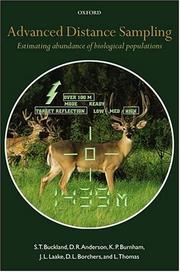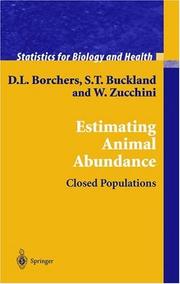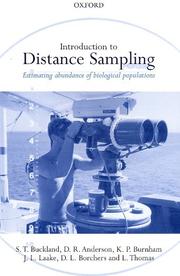| Listing 1 - 9 of 9 |
Sort by
|

ISBN: 1280758872 9786610758876 0191545198 1423753062 9781423753063 6610758875 0198507836 9780198507833 0198507836 9781280758874 9780191545191 1383021759 Year: 2023 Publisher: Oxford : Oxford University Press,
Abstract | Keywords | Export | Availability | Bookmark
 Loading...
Loading...Choose an application
- Reference Manager
- EndNote
- RefWorks (Direct export to RefWorks)
Addressing new methodologies and technologies, this text focuses on the use of distance sampling to estimate the density and abundance of biological populations.
Population biology --- Sampling (Statistics) --- Biology --- Health & Biological Sciences --- Biology - General --- Random sampling --- Statistics of sampling --- Statistics --- Mathematical statistics --- Statistical methods --- Statistical methods. --- Sampling (Statistics). --- Sampling (Statisticts)

ISBN: 1852335602 Year: 2002 Publisher: London Springer
Abstract | Keywords | Export | Availability | Bookmark
 Loading...
Loading...Choose an application
- Reference Manager
- EndNote
- RefWorks (Direct export to RefWorks)
Animal populations --- 57.087.1 --- 574.3 --- 591.9 --- 57.087.1 Biometry. Statistical study and treatment of biological data --- Biometry. Statistical study and treatment of biological data --- 591.9 Geographic zoology. Zoogeography. Fauna. Geographic distribution of animals --- Geographic zoology. Zoogeography. Fauna. Geographic distribution of animals --- 574.3 Populations and environment. Population dynamics --- Populations and environment. Population dynamics --- Estimates of animal populations --- Zoology --- Animals --- Estimates --- Technique --- Counting --- Mathematical statistics --- Biomathematics. Biometry. Biostatistics
Book
ISBN: 3319192191 3319192183 Year: 2015 Publisher: Cham : Springer International Publishing : Imprint: Springer,
Abstract | Keywords | Export | Availability | Bookmark
 Loading...
Loading...Choose an application
- Reference Manager
- EndNote
- RefWorks (Direct export to RefWorks)
In this book, the authors cover the basic methods and advances within distance sampling that are most valuable to practitioners and in ecology more broadly. This is the fourth book dedicated to distance sampling. In the decade since the last book published, there have been a number of new developments. The intervening years have also shown which advances are of most use. This self-contained book covers topics from the previous publications, while also including recent developments in method, software and application. Distance sampling refers to a suite of methods, including line and point transect sampling, in which animal density or abundance is estimated from a sample of distances to detected individuals. The book illustrates these methods through case studies; data sets and computer code are supplied to readers through the book’s accompanying website. Some of the case studies use the software Distance, while others use R code. The book is in three parts. The first part addresses basic methods, the design of surveys, distance sampling experiments, field methods and data issues. The second part develops a range of modelling approaches for distance sampling data. The third part describes variations in the basic method; discusses special issues that arise when sampling different taxa (songbirds, seabirds, cetaceans, primates, ungulates, butterflies, and plants); considers advances to deal with failures of the key assumptions; and provides a check-list for those conducting surveys. .
Statistics. --- Ecology. --- Animal ecology. --- Statistics for Life Sciences, Medicine, Health Sciences. --- Community & Population Ecology. --- Animal Ecology. --- Animals --- Zoology --- Ecology --- Balance of nature --- Biology --- Bionomics --- Ecological processes --- Ecological science --- Ecological sciences --- Environment --- Environmental biology --- Oecology --- Environmental sciences --- Population biology --- Statistical analysis --- Statistical data --- Statistical methods --- Statistical science --- Mathematics --- Econometrics --- Sampling (Statistics) --- Mathematical statistics. --- Geospatial data. --- Random sampling --- Statistics of sampling --- Statistics --- Mathematical statistics --- Data, Geospatial --- Geographic information systems --- Statistical inference --- Statistics, Mathematical --- Probabilities --- Statistics . --- Community ecology, Biotic. --- Biocenoses --- Biocoenoses --- Biogeoecology --- Biological communities --- Biomes --- Biotic community ecology --- Communities, Biotic --- Community ecology, Biotic --- Ecological communities --- Ecosystems --- Natural communities
Book
ISBN: 9783319192185 9783319192192 9783319192208 9783319371962 Year: 2015 Publisher: Switzerland : Spinger,
Abstract | Keywords | Export | Availability | Bookmark
 Loading...
Loading...Choose an application
- Reference Manager
- EndNote
- RefWorks (Direct export to RefWorks)
In this book, the authors cover the basic methods and advances within distance sampling that are most valuable to practitioners and in ecology more broadly. This is the fourth book dedicated to distance sampling. In the decade since the last book published, there have been a number of new developments. The intervening years have also shown which advances are of most use. This self-contained book covers topics from the previous publications, while also including recent developments in method, software and application. Distance sampling refers to a suite of methods, including line and point transect sampling, in which animal density or abundance is estimated from a sample of distances to detected individuals. The book illustrates these methods through case studies; data sets and computer code are supplied to readers through the book’s accompanying website. Some of the case studies use the software Distance, while others use R code. The book is in three parts. The first part addresses basic methods, the design of surveys, distance sampling experiments, field methods and data issues. The second part develops a range of modelling approaches for distance sampling data. The third part describes variations in the basic method; discusses special issues that arise when sampling different taxa (songbirds, seabirds, cetaceans, primates, ungulates, butterflies, and plants); considers advances to deal with failures of the key assumptions; and provides a check-list for those conducting surveys.
Digital
ISBN: 9783319192185 9783319192192 9783319192208 9783319371962 Year: 2015 Publisher: Cham Springer
Abstract | Keywords | Export | Availability | Bookmark
 Loading...
Loading...Choose an application
- Reference Manager
- EndNote
- RefWorks (Direct export to RefWorks)
In this book, the authors cover the basic methods and advances within distance sampling that are most valuable to practitioners and in ecology more broadly. This is the fourth book dedicated to distance sampling. In the decade since the last book published, there have been a number of new developments. The intervening years have also shown which advances are of most use. This self-contained book covers topics from the previous publications, while also including recent developments in method, software and application. Distance sampling refers to a suite of methods, including line and point transect sampling, in which animal density or abundance is estimated from a sample of distances to detected individuals. The book illustrates these methods through case studies; data sets and computer code are supplied to readers through the book’s accompanying website. Some of the case studies use the software Distance, while others use R code. The book is in three parts. The first part addresses basic methods, the design of surveys, distance sampling experiments, field methods and data issues. The second part develops a range of modelling approaches for distance sampling data. The third part describes variations in the basic method; discusses special issues that arise when sampling different taxa (songbirds, seabirds, cetaceans, primates, ungulates, butterflies, and plants); considers advances to deal with failures of the key assumptions; and provides a check-list for those conducting surveys. .


ISBN: 019850649X 0198509278 Year: 2001 Publisher: Oxford : Oxford University Press,
Abstract | Keywords | Export | Availability | Bookmark
 Loading...
Loading...Choose an application
- Reference Manager
- EndNote
- RefWorks (Direct export to RefWorks)
Offers a comprehensive introduction to distance sampling, a statistical method used by many biologists and conservationists to estimate animal abundance. The text discusses point transect sampling and line transect sampling and also describes several other related techniques. There are updates on study design and field methods, laser range finders, theodolites and the GPS and advice is given on a wide range of survey methods. Analysis methods have also been generalized, through the use of various types of multiplier and exercises for students in wildlife and conservation management are included.
Échantillonnage --- Sampling --- Technique analytique --- Analytical methods --- Surveillance --- monitoring --- Population animale --- Animal population --- Densité de population --- population density --- Méthode statistique --- Statistical methods --- Animal populations --- Sampling (Statistics) --- Estimates. --- Sampling (Statistics).
Book

ISBN: 1493909770 1493909762 Year: 2014 Publisher: New York, NY : Springer New York : Imprint: Springer,
Abstract | Keywords | Export | Availability | Bookmark
 Loading...
Loading...Choose an application
- Reference Manager
- EndNote
- RefWorks (Direct export to RefWorks)
This book gives a unifying framework for estimating the abundance of open populations: populations subject to births, deaths and movement, given imperfect measurements or samples of the populations. The focus is primarily on populations of vertebrates for which dynamics are typically modelled within the framework of an annual cycle, and for which stochastic variability in the demographic processes is usually modest. Discrete-time models are developed in which animals can be assigned to discrete states such as age class, gender, maturity, population (within a metapopulation), or species (for multi-species models). The book goes well beyond estimation of abundance, allowing inference on underlying population processes such as birth or recruitment, survival and movement. This requires the formulation and fitting of population dynamics models. The resulting fitted models yield both estimates of abundance and estimates of parameters characterizing the underlying processes. .
Population --- Statistics. --- Statistical methods. --- Mathematical models. --- Statistical analysis --- Statistical data --- Statistical methods --- Statistical science --- Mathematics --- Econometrics --- Statistics for Life Sciences, Medicine, Health Sciences. --- Statistics .
Book

ISBN: 9781493909766 Year: 2014 Publisher: New York, N.Y. Springer
Abstract | Keywords | Export | Availability | Bookmark
 Loading...
Loading...Choose an application
- Reference Manager
- EndNote
- RefWorks (Direct export to RefWorks)
Digital

ISBN: 9781493909773 Year: 2014 Publisher: New York, NY Springer
Abstract | Keywords | Export | Availability | Bookmark
 Loading...
Loading...Choose an application
- Reference Manager
- EndNote
- RefWorks (Direct export to RefWorks)
This book gives a unifying framework for estimating the abundance of open populations: populations subject to births, deaths and movement, given imperfect measurements or samples of the populations. The focus is primarily on populations of vertebrates for which dynamics are typically modelled within the framework of an annual cycle, and for which stochastic variability in the demographic processes is usually modest. Discrete-time models are developed in which animals can be assigned to discrete states such as age class, gender, maturity, population (within a metapopulation), or species (for multi-species models). The book goes well beyond estimation of abundance, allowing inference on underlying population processes such as birth or recruitment, survival and movement. This requires the formulation and fitting of population dynamics models. The resulting fitted models yield both estimates of abundance and estimates of parameters characterizing the underlying processes. .
Statistical science --- Biomathematics. Biometry. Biostatistics --- medische statistiek --- biostatistiek --- statistiek --- biometrie
| Listing 1 - 9 of 9 |
Sort by
|

 Search
Search Feedback
Feedback About
About Help
Help News
News